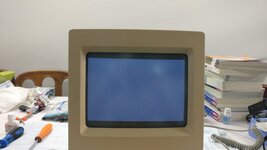Fiat131Mirafiori
Member
Hello everyone!
I've got myself a nice Macintosh Classic with leaking caps but hopefully no battery leakage and in very good conditions. It was a nice deal!
I've started with replacing the caps indicated by this link, both AB and logic board. Since the RIFA capacitors were cracked, I went ahead and replaced those too. A general alcohol scrub of the boards was of course needed.
The startup case up until now was a minute of slowly rising voltage in the 5V floppy port pin (starting from 4.70V) with horizontal bars and wobbly screen on CRT, up until 4.85V where the computer manages to boot and from there it's perfectly usable (minus the constant screen wobbling).
I've went ahead and replaced DP4 and DP3 with 1N4148 diodes, QP1 with CNY17-2X (I've been told by shop staff that it's a comparable replacement) and reflowed all the connections from the AB to the CRT and logic board (flyback included as it had a small crack on the solder).
At my startup attempt, the main fuse got blow the moment I flipped the switch. There are no visible shorts on board (tested for continuity between connections with multimeter just to make sure) and all components I've replaced in this second phase are correctly oriented.
I've taken a look at the forum and it might be the case that the TDA4605 chip and the IRFBC40 MOSFET are now liable for a replacement, but I am afraid that something else might be the cause of this. Maybe CNY17-2X is not so comparable after all, but could an optoisolator blow a fuse just like that? Could the TDA IC and linked MOSFET die so easily between one boot and another?
Thanks for your replies!
I've got myself a nice Macintosh Classic with leaking caps but hopefully no battery leakage and in very good conditions. It was a nice deal!
I've started with replacing the caps indicated by this link, both AB and logic board. Since the RIFA capacitors were cracked, I went ahead and replaced those too. A general alcohol scrub of the boards was of course needed.
The startup case up until now was a minute of slowly rising voltage in the 5V floppy port pin (starting from 4.70V) with horizontal bars and wobbly screen on CRT, up until 4.85V where the computer manages to boot and from there it's perfectly usable (minus the constant screen wobbling).
I've went ahead and replaced DP4 and DP3 with 1N4148 diodes, QP1 with CNY17-2X (I've been told by shop staff that it's a comparable replacement) and reflowed all the connections from the AB to the CRT and logic board (flyback included as it had a small crack on the solder).
At my startup attempt, the main fuse got blow the moment I flipped the switch. There are no visible shorts on board (tested for continuity between connections with multimeter just to make sure) and all components I've replaced in this second phase are correctly oriented.
I've taken a look at the forum and it might be the case that the TDA4605 chip and the IRFBC40 MOSFET are now liable for a replacement, but I am afraid that something else might be the cause of this. Maybe CNY17-2X is not so comparable after all, but could an optoisolator blow a fuse just like that? Could the TDA IC and linked MOSFET die so easily between one boot and another?
Thanks for your replies!



